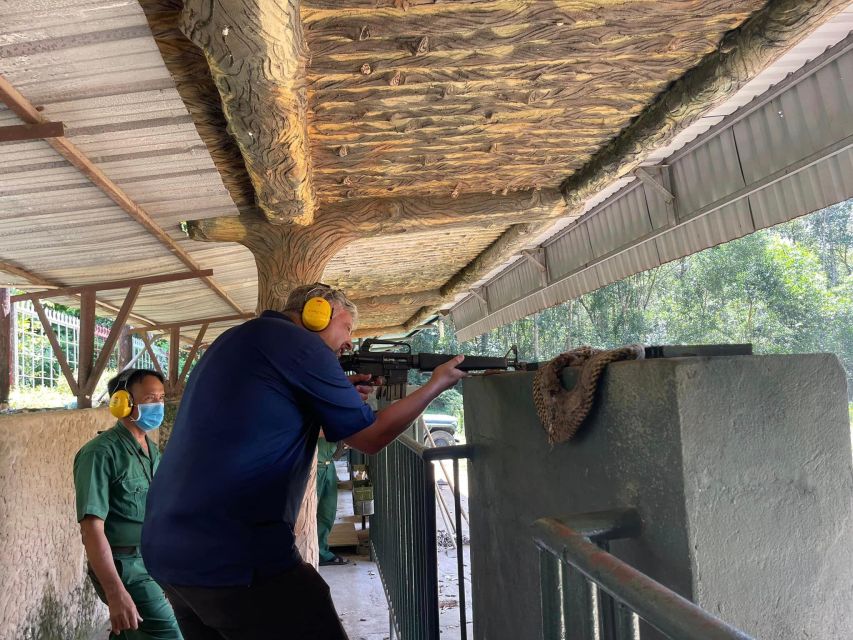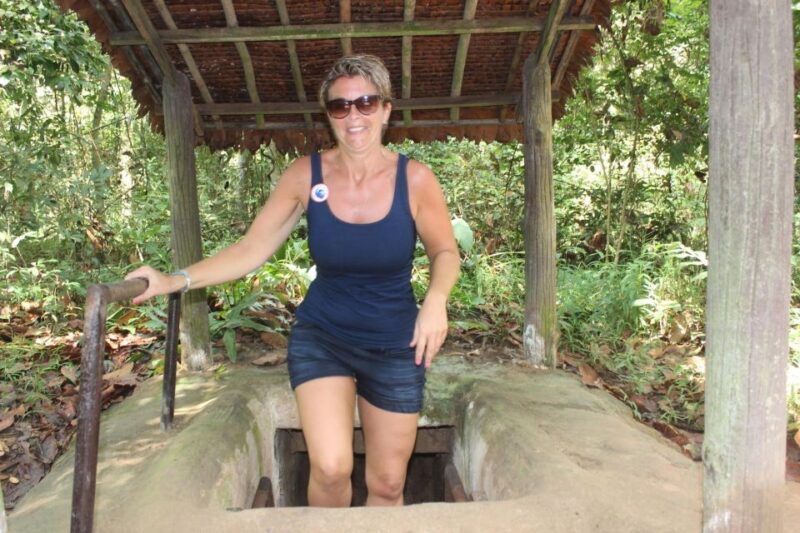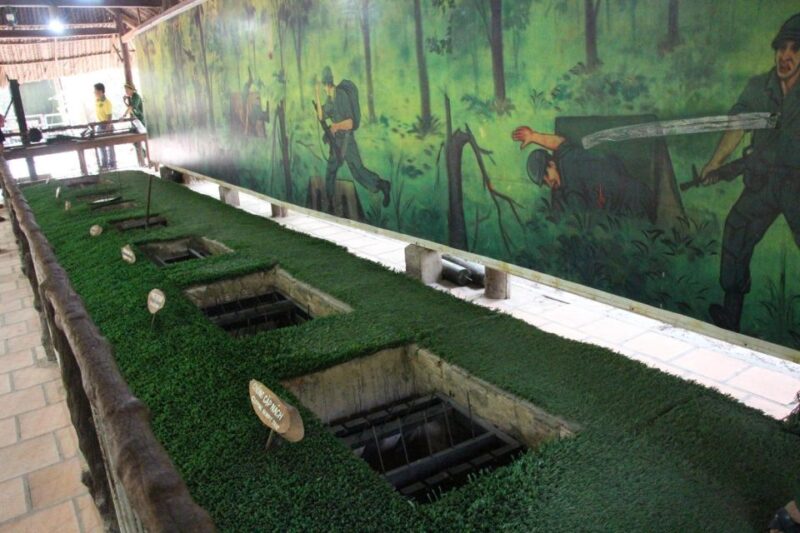The Cu Chi Tunnels near Ho Chi Minh City stand as a testament to Vietnam’s wartime resilience and ingenuity. This vast underground network, utilized by the Viet Cong during the Vietnam War, not only facilitated surprise attacks but also provided essential shelter for soldiers. Visitors can explore these narrow passageways, watch compelling wartime documentaries, and even sample traditional wartime cuisine, all of which reveal layers of history that shaped the nation. Yet, the true stories behind these tunnels and their impact on the Vietnamese spirit remain to be uncovered.
This experience made our list of the 20 Best Historical Tours In Ho Chi Minh City.
Key Points

- The Cu Chi Tunnels served as a strategic underground network used during the Vietnam War, facilitating surprise attacks and guerrilla warfare.
- Visitors can explore the narrow tunnels to gain firsthand insight into the living conditions of Vietnamese fighters during wartime.
- The tour includes historical documentaries that provide valuable context about Vietnam’s war efforts and the significance of the tunnels.
- Guests can experience traditional wartime food, such as tapioca prepared on a Hoang Cam stove, enhancing cultural understanding.
- Nearby attractions, like the War Remnants Museum, offer additional perspectives on Vietnam’s history and resilience during the war.
Tour Overview and Pricing

The Cu Chi Tunnels tour offers an engaging 6-hour experience for visitors, allowing them to explore Vietnam’s rich history at a discounted price of €26.26 per person.
Originally priced at €29.18, this tour provides a 10% savings, making it an accessible option for history enthusiasts.
Guests can enjoy the convenience of free cancellation up to 24 hours in advance for a full refund, plus a reserve now, pay later option.
The tour includes pick-up and drop-off from central Saigon, ensuring a hassle-free experience.
Visitors will benefit from a friendly and professional tour guide, who shares insights into the historical significance of the tunnels.
Bottled water and entrance fees are also included, enhancing the overall value of the tour.
You can also read our reviews of more historical tours in Ho Chi Minh City
Experience Highlights
Explore the intricate tunnel network of Cu Chi, where visitors can discover rooms, hospitals, and weapons factories that reveal the ingenuity of guerrilla warfare. This immersive experience offers a glimpse into the resilience and creativity of the Vietnamese fighters during the war.
Highlights include:
-
Crawling through narrow tunnels: Visitors can experience the claustrophobic conditions that the guerrillas lived in, enhancing their understanding of the challenges they faced.
-
Watching documentaries: Authentic war footage provides context to the historical significance of the tunnels.
-
Tasting wartime food: Guests can enjoy tapioca prepared on a Hoang Cam stove, a staple during the conflict, adding a unique culinary touch to their visit.
These engaging activities ensure a memorable journey through history.
Inclusions

Visitors can enjoy a range of inclusions that enhance their experience at the Cu Chi Tunnels, ensuring a comfortable and informative visit.
The tour package provides convenient pick-up and drop-off services from central Saigon, making travel hassle-free. A friendly and professional tour guide accompanies guests, sharing insights and stories about the site’s historical significance.
Each participant receives bottled water and entrance fees, along with a light snack of tapioca and tea, an authentic taste of wartime sustenance.
While the tour covers many essentials, personal expenses and tips aren’t included. For those interested in the shooting range, bullet fees apply, adding an optional thrill to the experience.
Participant Information
Participants in the Cu Chi Tunnels tour can include adults aged 12 to 99, children between 4 and 11, and infants aged 3 and younger. Families can enjoy this immersive experience together, as the tour caters to a wide age range.
Here are a few key points about participant information:
-
Age Restrictions: Adults must be aged 12 or older, while children ages 4-11 are welcome. Infants aged 3 and younger can join for free, without a ticket.
-
Group Dynamics: The tour encourages group participation, making it a great option for families or friends.
-
Accessibility: The tour accommodates various fitness levels, ensuring everyone has a memorable experience exploring history.
This inclusive approach enhances the adventure for all participants.
More Great Tours NearbyCustomer Feedback
Customer feedback highlights a mix of experiences, reflecting both the engaging aspects of the Cu Chi Tunnels tour and areas where improvements could be made. While some participants appreciate the informative guides and unique insights into guerrilla life, others mention that the tour could benefit from better organization and clearer instructions.
| Aspect | Positive Feedback | Areas for Improvement |
|---|---|---|
| Tour Guides | Knowledgeable and friendly | Some lacked engagement |
| Tunnel Experience | Authentic and immersive | More time needed in certain areas |
| Overall Value | Affordable pricing | More detailed itinerary required |
| Snack Experience | Enjoyable tapioca | Limited snack options |
| Shooting Experience | Exciting for enthusiasts | Additional safety measures suggested |
Such feedback helps future visitors make informed decisions.
- A Taste of Vietnam
- Small-group Mekong Delta Day Trip: Boat Ride, Village & Cooking
- Full Day Experience Mekong Delta By Bike, Boat and Kayak.
- Saigon By Night and Street Food By Motorbike |Opt: Ao Dai Riders
- Cu Chi Tunnels Small Group Tour – Morning Trip With English Guide
- Private Insight Mekong Delta (Day Trip)
Historical Significance

The Cu Chi Tunnels play a crucial role in Vietnam’s history, showcasing the ingenuity and resilience of the Vietnamese people during the Vietnam War. These intricate tunnels symbolize the country’s struggle for independence and the innovative tactics employed by the Viet Cong.
Strategic Advantage: The tunnels provided crucial cover and facilitated surprise attacks against enemy forces, proving pivotal in many battles.
Cultural Heritage: They represent the spirit of resistance and the sacrifices made by generations, serving as a reminder of the war’s impact on Vietnamese society.
Tourism and Education: Today, the tunnels attract visitors worldwide, educating them about Vietnam’s history and fostering a deeper understanding of the war’s complexities.
Through these aspects, the Cu Chi Tunnels remain a significant historical landmark.
Tips for Visitors

Before embarking on the adventure through the Cu Chi Tunnels, visitors should consider wearing comfortable clothing and sturdy footwear to navigate the narrow passages more easily.
It’s essential to stay hydrated, so carrying a water bottle is advisable, even though bottled water is provided on the tour.
Visitors can enhance their experience by watching the documentaries and authentic war footage, offering valuable insights into the tunnel’s history.
Those who are interested in trying traditional wartime food shouldn’t miss the tapioca snack.
Lastly, be prepared for an optional shooting experience, but keep in mind the additional costs involved.
Planning ahead ensures a rewarding and memorable visit to this historical site.
Nearby Attractions
Visitors to the Cu Chi Tunnels can enhance their experience by exploring several nearby attractions that further illuminate Vietnam’s rich history and culture. Each site offers unique insights into the country’s past and showcases its resilience.
-
War Remnants Museum: This museum presents a powerful collection of photographs and artifacts from the Vietnam War, providing a deeper understanding of its impact on the nation.
-
Ben Duoc Memorial Site: Located nearby, this site honors the soldiers and civilians who sacrificed their lives during the war, featuring monuments and a serene landscape.
-
Cu Chi Wildlife Rescue Station: This sanctuary focuses on rehabilitating and protecting native wildlife, offering visitors a chance to learn about conservation efforts in Vietnam.
These attractions complement the history experienced at the tunnels, creating a well-rounded visit.
Frequently Asked Questions

What Should I Wear for the Cu Chi Tunnels Tour?
For the Cu Chi Tunnels tour, participants should wear comfortable clothing, sturdy shoes, and bring a hat or sunscreen. They’ll find the tunnels narrow and the terrain uneven, so practicality is key for an enjoyable experience.
Is the Tour Suitable for Individuals With Mobility Issues?
The tour’s not highly recommended for individuals with mobility issues, as navigating the narrow tunnels and uneven terrain can pose challenges. Participants should consider their physical abilities before booking to ensure a comfortable experience.
Can I Take Photos Inside the Tunnels?
Visitors can take photos inside the tunnels, but they should respect the guidelines set by the tour guide. Capturing memories is encouraged, yet maintaining the site’s historical integrity remains a priority during the experience.
Are There Any Age Restrictions for the Shooting Experience?
There’re age restrictions for the shooting experience. Participants must be at least 12 years old. Younger you can explore the tunnels, but they’ll need to wait for their chance to shoot at the range.
What Is the Best Time of Year to Visit the Cu Chi Tunnels?
The best time to visit the Cu Chi Tunnels is during the dry season, from December to April. During these months, visitors enjoy pleasant weather, making exploration of the tunnels and surrounding areas more enjoyable.
Recap
Visiting the Cu Chi Tunnels is an unforgettable experience that offers deep insights into Vietnam’s wartime resilience.
Exploring the intricate tunnel systems and learning about the innovative strategies of the Viet Cong leaves a lasting impression on every visitor.
With its rich history and engaging activities, the tour not only educates but also honors the spirit of those who endured during the war.
A trip to these tunnels is a must for anyone wanting to understand Vietnam’s past.
You can check availability for your dates here:More Historical Tours in Ho Chi Minh City
- Ho Chi Minh City: Top Sightseeing Saigon Trip & History Tour
- From Ho Chi Minh: The Historical Cu Chi Tunnels Private Tour
- From Ho Chi Minh City: Culture History Massage Private Tour
- Ho Chi Minh City: Half-day History And Culture Tour
- Saigon: Sunset Café Experience at Landmark 81 and Food Tour
- HoChiMinh: Discover Cu Chi Tunnels-A Journey Through History
More Tour Reviews in Ho Chi Minh City
- Mekong Delta Full Day – My Tho & Ben Tre – Four Islands Tour
- Cu Chi Tunnels, Cao Dai Temple, Ba Den Mountain Full Day
- Ho Chi Minh City: Mekong Delta Day Trip With Lunch & Drinks
- Saigon at Sunset: Ultimate Street Food Experience
- Ho Chi Minh City: Top Sightseeing Saigon Trip & History Tour
- Private Cooking Class Tour With Female Guide In Ho Chi Minh
Not for you? Here's more nearby things to do in Ho Chi Minh City we have reviewed
- Mekong Delta Full Day – My Tho & Ben Tre – Four Islands Tour
- Cu Chi Tunnels, Cao Dai Temple, Ba Den Mountain Full Day
- Ho Chi Minh City: Mekong Delta Day Trip With Lunch & Drinks
- Saigon at Sunset: Ultimate Street Food Experience
- Ho Chi Minh City: Top Sightseeing Saigon Trip & History Tour
- Private Cooking Class Tour With Female Guide In Ho Chi Minh
- Ho Chi Minh City Sightseeing Full-Day Tour With Great Guide
- Essential Mekong Delta: Highlight Tour From Ho Chi Minh City
- Cu Chi Tunnels, Cao Dai Temple, Ba Den Mountain Full Day
- Fastrack at Cam Ranh ( CXR) International Airport (Option)
- Vietnamese Craft Liquor Tasting Led by Food & Drink Writer
- HCM: 2-Day Mekong Floating Market With Cooking & Bike Ride
